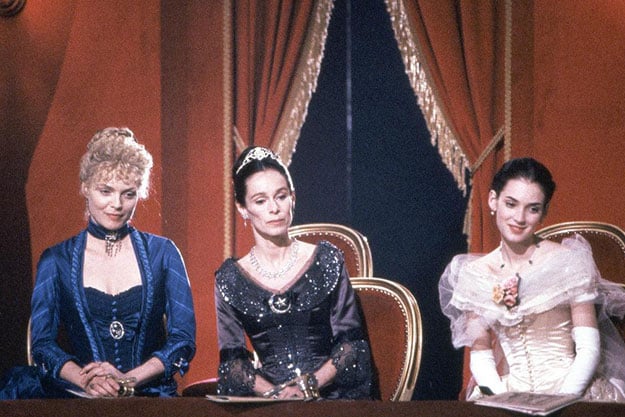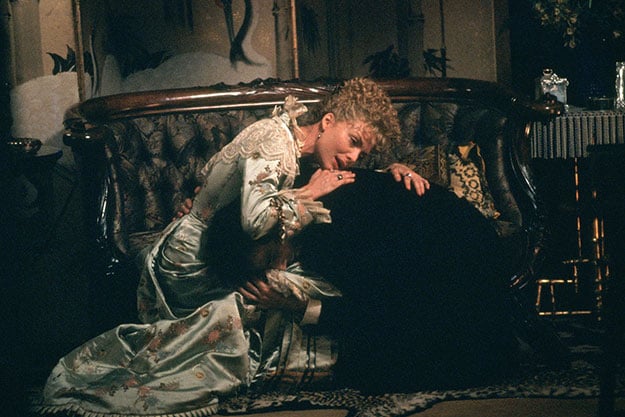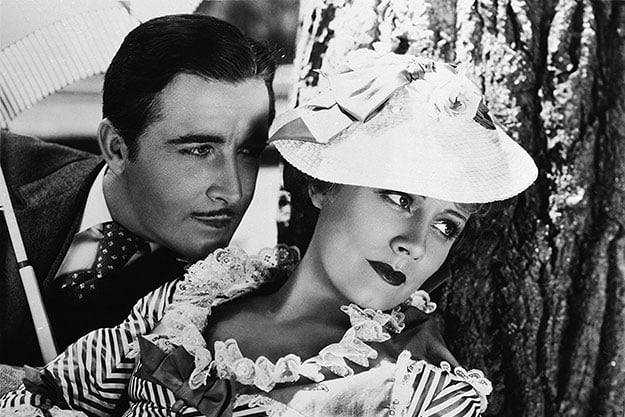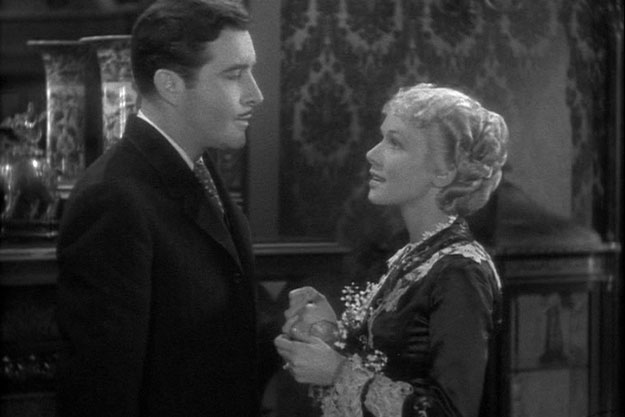TCM Diary: Ages of Innocence

When Martin Scorsese adapted Edith Wharton’s The Age of Innocence in 1993, he judged the result to be the most violent film he’d ever made, though it contains not a single burst of gunfire, and with one jarring exception the characters speak in hushed, polite tones. But there’s a scene toward the end where the truth of his claim is made manifest, as two pillars of Gilded Age society debate the prospects of a cousin who had the misfortune to marry a Polish count who preferred the company of prostitutes. Sequestered in New York where she incurs the vilest of gossip and dissuaded from seeking a divorce to spare her relatives further shame, the Countess (Michelle Pfeiffer) must now become a rich man’s mistress or return to Europe in disgrace. “The rest of the family have no particular interest in keeping her here—they’ll simply let her find her own level,” the elder man proclaims, stubbing out his cigar and the life of the film’s one true innocent.
Nothing in Taxi Driver or Goodfellas can compare to the cruelty of this ’70s New York mob—though the milieu is Manhattan in the 1870s, and the family heads protect their holdings with marriage, not machine guns, brokering unions among their scions that keep wealth and power intact. So it goes that Newland Archer (Daniel Day-Lewis) dutifully weds the complacent May Welland (Winona Ryder) despite his thwarted passion for May’s cousin, the Countess, and eventually their children enter into matrimony with the offspring of two key supporting figures, both insufferable boors.
One is tempted to read the title as acrid irony, with the stifling mores of the upper crust systematically quelling all traces of innocence or uniqueness. (The Countess betrays her naïveté when she asks Newland, “Is New York such a labyrinth? I thought it was all straight up and down like Fifth Avenue. All the cross streets numbered and big honest labels on everything.” “Everything is labeled, but everybody is not,” he knowingly replies.) But just as Orson Welles retained the nostalgia for the horse-and-buggy Midwest of Booth Tarkington’s The Magnificent Ambersons (which took the Pulitzer Prize for fiction two years before Wharton earned it for The Age of Innocence), Scorsese does not forsake the author’s fondness for what she called “my childish memories of a long-vanished America… the world I had grown up in and been formed by [which] had been destroyed in 1914.” It’s entirely possible to watch The Age of Innocence with the sound off and melt into Dante Ferretti’s sumptuous sets, the walls crowded with fashionable paintings and Tiffany china, the burgundy drapes and furniture pulsing with the vitality the populace so studiously curbs.

“They all lived in a kind of hieroglyphic world; the real thing was never said or done or even thought, but only represented by a set of arbitrary signs,” we’re told early on by the narrator, an unseen character whose haughty but incisive observations (majestically scripted by Scorsese and frequent collaborator Jay Cocks) impart atmosphere as well as exposition. Voiced by a dryly sophisticated Joanne Woodward, the narrator emerges as the fourth lead, shouldering ample narrative freight without ever seeming like a screenwriter’s cheat. She proves especially valuable in the introductory passages, whisking us through the drawing rooms of the Beaufort manor where seemingly all New York attends a post-opera ball, suggesting a codified sense of captivity that runs counter to the late Michael Ballhaus’s free-range camera.
Despite its panorama of demure characters, The Age of Innocence stands as one of Scorsese’s most visually dynamic productions, with iris-like spotlighting within the frame, bursts of color inspired by Black Narcissus and Rear Window, and the aforementioned prowl of the Beaufort estate uncannily echoing Ballhaus’s legendary nightclub sequence from Goodfellas, as tuxedoed party guests nod approvingly at Newland one step ahead of the Steadicam. Elmer Bernstein’s plaintive score recalls the soundscape of studio melodramas in which true love crashes against public obligation (many of which he composed, e.g., Some Came Running, From the Terrace), and Thelma Schoonmaker’s editing again serves as Scorsese’s secret weapon and key identifier (in her hands, the cutting and lighting of cigars at a party resembles a 19th-century cocaine orgy).
Day-Lewis, as cerebral here as he would be visceral a decade later in Scorsese’s Gangs of New York, brilliantly vacillates between the conventions in which he’s embroiled and the progressive views he struggles to suppress. Pfeiffer allows the Countess’s piercing wit to shine through her placid façade: when Newland states that he’s as much in love with May as a man can be, she asks if there’s a limit; all at once he sees what he is missing with his shallow, dispassionate fiancée.

Despite her Oscar nomination, Ryder’s portrayal continues to divide critics. She lacks Pfeiffer’s poise—ironic, since her character moves fluidly among the haut monde, not the Countess—and her wide grin at meeting Newland at the Beauforts’ ball is perhaps more overstated than necessary. But she captures May’s unquestioning nature and elected simplicity, in an agreeable break from the Gen-X misfits she was playing at the time, and lives up to the narrator’s scathing characterization of her: “There was no use trying to emancipate a wife who hadn’t the dimmest notion she was not free.”
While Scorsese’s take on Wharton’s 1920 novel is definitive, it was not the first screen treatment. A silent version was produced by Warner Brothers four years after the book’s publication, and in 1934 RKO acquired it as a sound vehicle for stars Irene Dunne and John Boles. Paradoxically, the most exciting part of this adaptation has nothing to do with the original work: a Roaring Twenties montage of a type common in early sound cinema, filled with cotton club performers, prizefights, flowing champagne, and other hallmarks of the decade immediately following the book’s authorship. It establishes a framing story, which builds to the novel’s heartbreaking near-reunion of Newland and the Countess but changes his companion from his son to his grandson (presumably to address the forward jump of 60 years instead of 26), and adds a superfluous wrinkle in the grandson’s own romantic dilemma.
Otherwise, Philip Moeller’s direction is tepid, and Boles, an off-the-rack ’30s leading man, could only externalize the torment Day-Lewis kept roiling beneath the surface as Newland. (It didn’t help that Sarah Y. Mason and Victor Heerman’s screenplay encumbered him with outbursts that spell out the story’s themes: “When we say dignity, we mean fear of what others will say! When we say decency, we mean hypocrisy!”) Moeller’s film finds more humor in the snobbery of the elite than Scorsese’s—the Countess’s family bemoans the “bird stuffers and dreadful people who write” inhabiting her newfound Chelsea neighborhood—but this removes much of the sting from their aspersions, as they seem incapable of ostracizing her but merely of clucking and scolding.

With its horizontal wipes and stagy blocking and music (the script was inspired by a 1928 play), the film is an artifact of its own age of innocence, lovingly if unknowingly capturing Hollywood on the cusp of the restrictive Production Code. But its foremost asset is Dunne as Countess Olenska, steadfast and poignant in equal measure. The people around her often comment on Olenska’s ability to reanimate dormant things or turn a dingy flat into a haven of good cheer, and she, too, blossoms as she finds love with the like-minded Newland. The life-giving metaphor is visualized in a lovely greenhouse scene where she observes the beauty and fragrance of organisms permitted to grow freely, but notes that “sometimes life can touch us and we die.”
Later, when Newland proposes they flee from judgmental eyes, she declines, recalling that she’s tried running away before and found only smaller, shabbier places, more permissive but just as poisonous to the soul. “You see, over there we think of over here, and here you think of over there. Now I know it isn’t anywhere. Now my eyes are open.” The older film may lack the violence of Scorsese’s rendering, but in Dunne’s valiant acquiescence, there’s nothing more brutal than innocence betrayed.
Martin Scorsese’s and Philip Moeller’s respective adaptations of The Age of Innocence will air on Sunday, October 1 on Turner Classic Movies.
Steven Mears received his MA in film from Columbia University, where he wrote a thesis on depictions of old age in American cinema.







